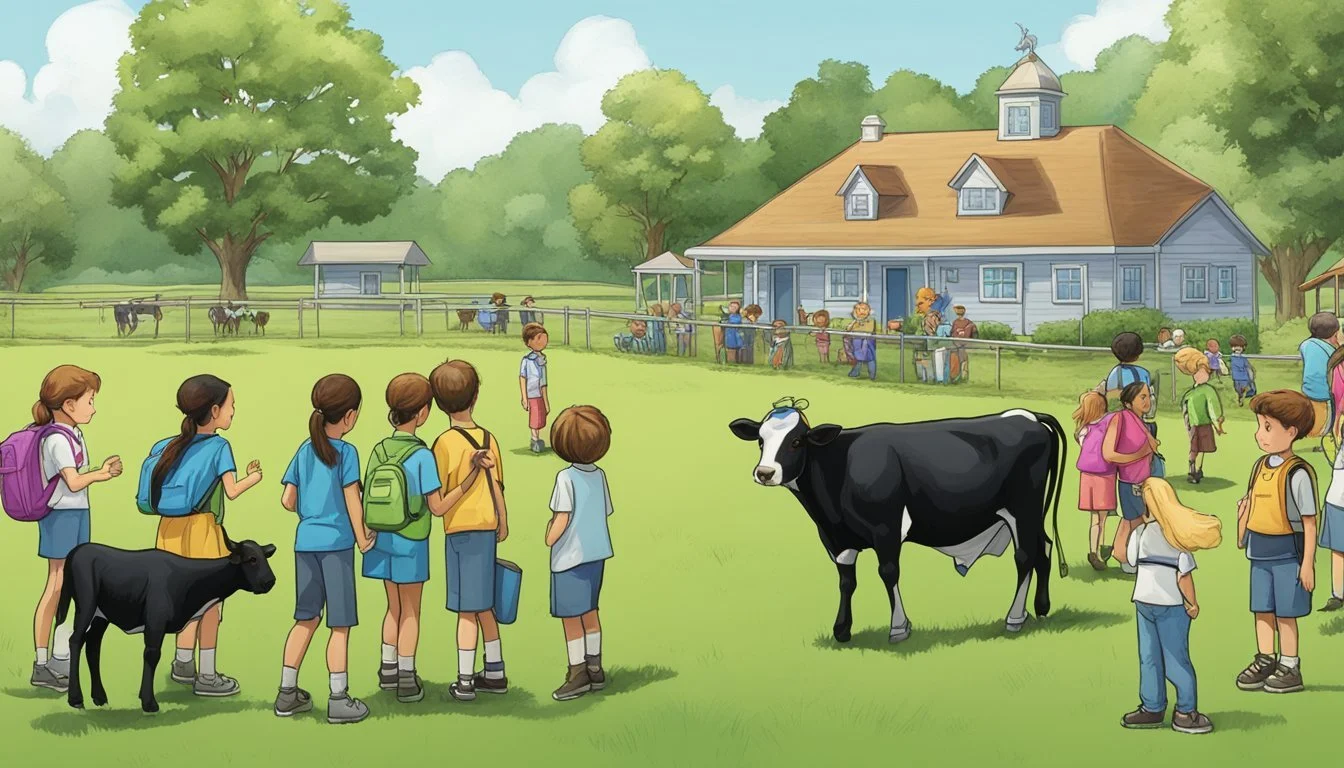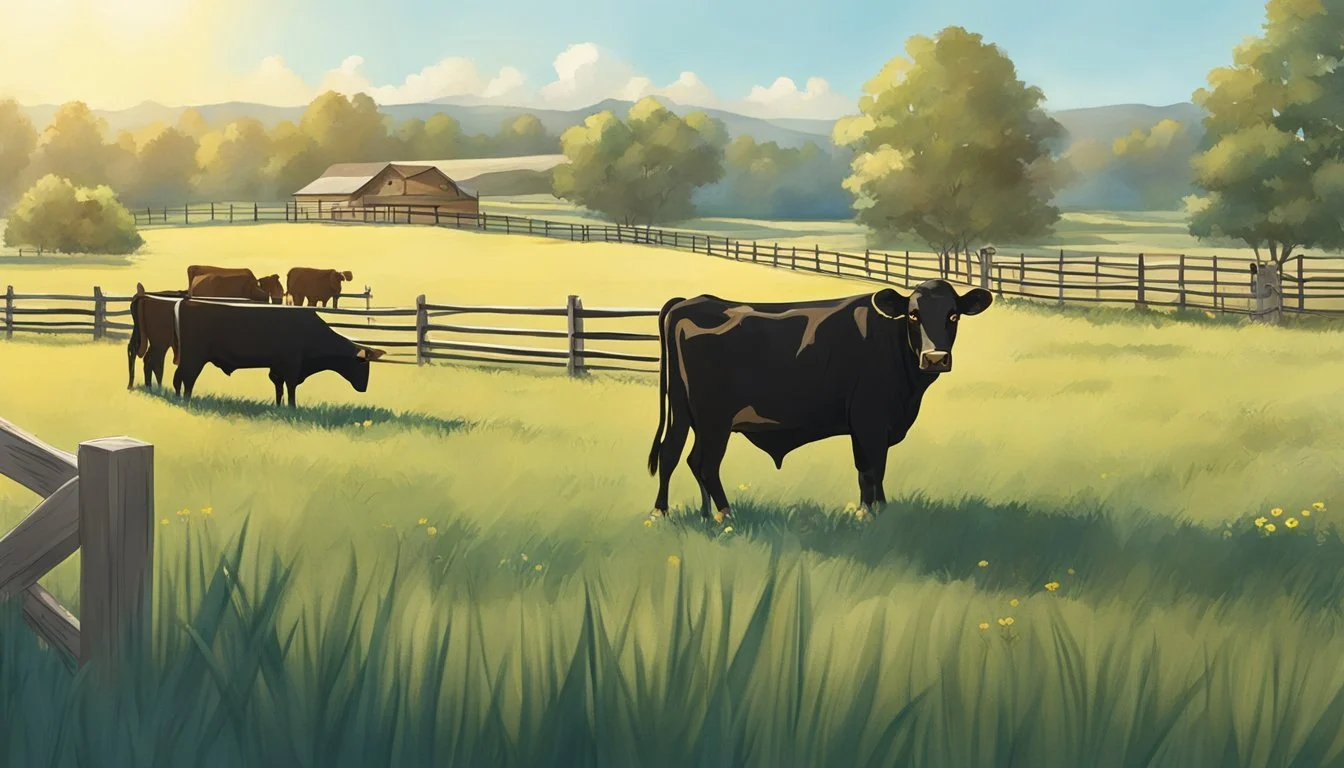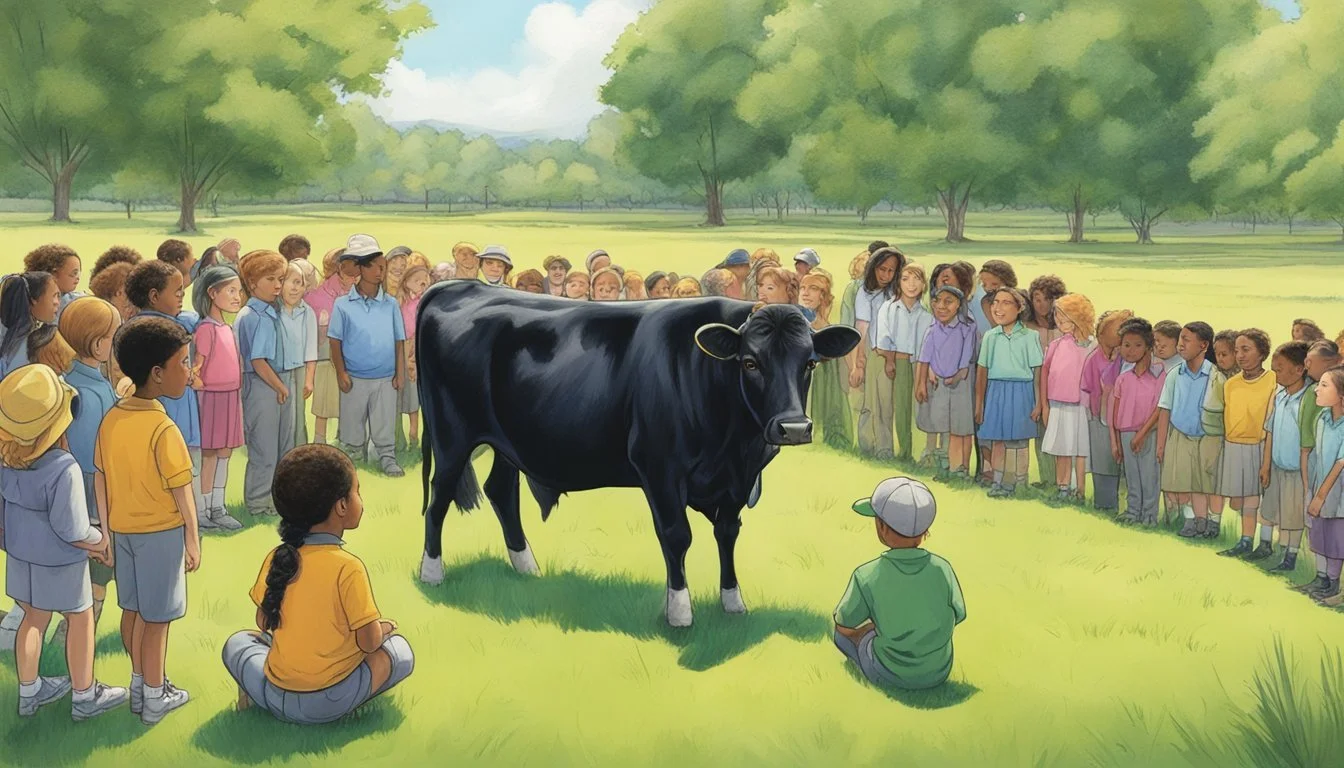Dexter Cattle and Educational Outreach
A Guide to Organizing School Field Trips
Dexter cattle, an attractively small and versatile breed, have become increasingly popular on farms engaged in educational outreach initiatives. These animals are known for their gentle nature, making them ideal candidates for interactive learning experiences with students of varying ages. When it comes to implementing hands-on agricultural education, many farms employ Dexter cattle as a focal point for school field trips. These excursions offer students the unique opportunity to witness sustainable farming practices firsthand and learn about the care and management of livestock.
Incorporating Dexters into educational programs helps to enrich the curriculum of schools by providing real-world contexts to classroom lessons. The intimate setting of a farm allows children to observe the day-to-day operations and understand where their food comes from. Many agritourism establishments do not charge for such educational visits, underscoring their commitment to public service and education. Engaging with Dexter cattle on these trips often includes activities such as feeding, milking demonstrations, and discussions about animal husbandry, all tailored to the students' age and education levels.
School field trips to farms with Dexter cattle not only connect the dots between theory and practice for students but also emphasize the importance of preserving local ecosystems and fostering sustainable agricultural communities. As a result, these experiences create lasting impressions that encourage environmental stewardship and a deeper appreciation for the intricacies of farming life. With the increased interest in agrarian education and community outreach, Dexter cattle have become synonymous with educational experiences that are both enlightening and memorable.
Understanding Dexter Cattle
Dexter cattle are a versatile and hardy breed ideal for education and small-scale agriculture. They offer unique opportunities for teaching due to their manageable size and temperament.
Origins and Characteristics
Origin: Dexter cattle originated from Ireland and have been historically valued for their small stature and efficient production.
Size: Adults are considerably smaller than many breeds, which contributes to their popularity on smaller farms.
Colors: They typically come in black, dun, or red.
Temperament: Known for their calm and friendly nature, Dexters are well-suited for interaction during educational activities.
Longevity: They are a hardy breed with a long productive life.
Dexter Cattle in Agriculture
Role: Dexter cattle are dual-purpose animals, utilized both for milk and beef.
Diet: They thrive on pasture-based diets but can also benefit from grain supplementation.
Adaptability: Their resilience allows them to adapt to various climates and agricultural settings, supporting the sustainability of diverse farming practices.
Educational Value of Dexter Cattle
Teaching Tool: Dexter cattle serve as an excellent resource for farm-based education due to their approachable size and nature.
Agriculture Insight: Through interaction with Dexters, students gain hands-on knowledge of animal husbandry and agriculture's role in food production.
Animal Husbandry and Care
Daily Care: Dexter cattle require basic livestock care, including proper nutrition, shelter, and preventative health measures.
Management: They are relatively low-maintenance, making them a suitable option for those new to farming and educational farms hosting field trips.
Dexter Cattle and Genetic Diversity
Breeding: Owners often promote naturally polled (hornless) Dexter cattle through selective breeding.
Conservation: Maintaining the genetic diversity within the Dexter breed is crucial for its sustainability and resilience, providing educational farms with an opportunity to contribute to agricultural biodiversity.
Designing Educational Field Trips
When planning educational field trips to a Dexter Cattle farm, organizers should focus on creating a structured yet engaging learning environment that fosters interaction and understanding for students of varying ages while ensuring their safety and accessibility needs are met.
Key Learning Outcomes
Educational field trips should be designed with clear learning objectives in mind. For Dexter Cattle farm visits, key outcomes might include understanding the life cycle and care requirements of Dexter Cattle, the environmental impact of sustainable farming, and the role of livestock in local agriculture. Each aspect of the field trip can be aligned with curriculum standards to reinforce classroom teaching.
Knowledge Transfer: Students should leave with a solid understanding of Dexter Cattle and sustainable farming practices.
Tailoring to Different Age Groups
School field trips must be customized to the developmental stages and educational needs of different age groups. For example:
Kindergarten to Grade 2: Use storytelling and basic concepts about farm animals.
Grades 3-5: Incorporate more detailed information about animal care and farming cycles.
Middle School: Engage in discussions about the agriculture industry and environmental considerations.
By adjusting the complexity of the information and activities, educators ensure that every student has an enriching and age-appropriate experience.
Interactive Learning Experiences
Hands-on workshops and interactive learning experiences are crucial for engaging students' senses and helping them form meaningful connections to the subject matter. On a Dexter Cattle farm, this could involve:
Guided tours with Q&A sessions
Demonstrations of daily farm operations
Opportunities to touch and feed the cattle under supervision
These interactions should aim to solidify the themes of the field trips while keeping the activities educational and entertaining.
Safety Measures and Accessibility
Safety is paramount on any school field trip, and appropriate measures must be integrated into the planning process:
Maintain a low student-to-chaperone ratio.
Clearly mark and communicate safe areas for interaction with the animals.
Ensure all pathways and facilities are accessible to students with mobility challenges.
By implementing robust safety and accessibility protocols, educators can provide a secure environment that allows all students to participate fully in the learning experience.
Incorporating Art and Creativity
Involving art and creativity in educational outreach programs elevates the learning experience, offering diverse ways to engage with agricultural subjects such as Dexter cattle. Varied artistic methods provide dynamic access points for students to explore farming themes, creating memorable connections with the material.
Art Projects with Agricultural Themes
Teachers can develop art projects that encourage students to use Dexter cattle as inspiration for their artwork. Activities might include drawing the distinctive red color of some Dexter cattle or creating mixed-media pieces that explore the various roles these cattle have on a farm. Using templates shaped like Dexter cattle, children can engage in painting or collage-making, incorporating real farm elements like hay or wool to create tactile artwork that connects to agricultural life.
Dexter Cattle in Art
Dexter cattle's unique physical characteristics offer a perfect subject for art education. Students can be tasked with observing and sketching live Dexter cattle during a field trip, focusing on form, texture, and color. This exercise not only enhances observational skills but also allows students to appreciate the aesthetics of this particular breed. Moreover, discussions can be woven into the curriculum about how this breed has been represented historically in various art forms.
Collaborations with Art Museums
Educational field trips can extend to art museums, where students can explore exhibits on agricultural themes. Partnering with local museums, schools can arrange for students to view artworks depicting farm life and animals, including cattle. This exposure broadens their understanding of how agriculture has been and can be represented in art. It also allows them to draw thematic connections between farming, history, and artistic representation.
Theater and Storytelling
The use of theater and storytelling in teaching about Dexter cattle can provide a vivid educational experience. By collaborating with local theaters, perhaps in Chicago or other cities, educators can arrange performances that tell stories about farm life, highlighting themes like cattle breeding or agricultural practices. Small skits or improv sessions can also encourage students to express their understanding of Dexter cattle in a performative and engaging manner.
Practical Considerations for Field Trips
When planning field trips for educational outreach, it's essential to address cost management, detailed logistics, an inclusive atmosphere, and the provision of supportive follow-up resources.
Cost and Funding for School Groups
Field trips often come with various expenses, including transportation, materials, and entrance fees. Funding can be sourced through school budgets, grants, or by requesting contributions from participants. It’s critical to provide transparent cost breakdowns for school groups and explore partnerships with local organizations to subsidize expenses.
Transportation: Bus rental costs, fuel, and driver payment.
Entrance Fees: Costs per student/teacher for the guided tour.
Materials: Workbooks, handouts, or equipment for interactive activities.
Subsidies: Seek sponsorships or educational grants to defray costs.
Logistics and Planning
The success of a field trip hinges on meticulous planning, encompassing transportation schedules, group management, and activity coordination. It’s imperative to ensure a clear itinerary for school groups and cover all logistical aspects.
Scheduling: Align with the school calendar and establish a timeline.
Group Management: Assign chaperones to small groups for better supervision.
Activities: Plan interactive and educational sessions with clear objectives.
Creating a Welcoming Environment
Providing a warm and inclusive atmosphere is essential to foster learning and engagement during field trips. Preparing staff to interact positively with students and ensuring accessibility to all participants is crucial.
Staff Briefing: Educate farm staff on how to engage with school students.
Facility Readiness: Make sure the farm is safe and welcoming to visitors.
Follow-up Activities and Materials
Sustaining the educational impact of the field trip requires follow-up in the classroom. Sending teachers back with relevant materials and suggesting post-visit activities can enhance the learning experience.
Educational Materials: Provide summary sheets, discussion questions, and additional information related to the visit.
Post-Visit Engagement: Recommend activities that reinforce the field topics discussed during the farm visit.
Extending the Experience
The efficacy of an educational field trip to a farm like a Dexter Cattle ranch extends well beyond the initial visit. It’s crucial to cement the knowledge gained on the trip by continued learning, community partnerships, and fostering long-lasting educational bonds.
Post-Visit Learning and Engagement
Educators can maximize students' exposure to Dexter Cattle and agricultural processes by integrating post-visit activities into classroom curricula. Assignments could include:
Essay: Students write about the Dexter Cattle's role in sustainable agriculture.
Project: Groups create a model of an optimized grazing system for cattle.
Discussion: A classroom forum on the importance of local produce.
This prolonged engagement helps solidify the field trip's educational impact, integrating real-world experiences with classroom instruction.
Partnerships with Local Businesses
Local businesses, such as dairy producers and ice cream shops, can collaborate with schools to extend the learning experience beyond the farm. For instance:
Dairy Producer Partnership: Students see the journey from farm to fridge by following the production line from Dexter Cattle cream to bottled milk.
Ice Cream Shop Engagement: Ice cream shops might offer interactive tours to educate students on how local ingredients are transformed into their favorite flavors.
These partnerships provide practical examples of how local businesses utilize produce and incorporate community resources into student enrichment.
Building Long-Term Educational Relationships
Fostering relationships between schools and Dexter Cattle farms can lead to continual educational enrichment. Programs may include:
Annual Visits: A yearly field trip to the farm to observe changes and growth.
Distance Learning Sessions: Regular virtual meet-ups with ranchers to track cattle development and ask questions.
Farm-to-School Programs: Farms supply schools with produce, creating a tangible link between education and local industry.
Sustained interaction not only reinforces information learned during the initial visit but also promotes an ongoing educational intervention that benefits both students and the local agricultural community.
Evaluating the Impact
Assessing the effectiveness of educational outreach through Dexter Cattle and school field trips includes gathering feedback, examining case studies, and analyzing research on educational outcomes.
Feedback and Continuous Improvement
Feedback from participants, educators, and facilitators is critical in gauging the success of field trips involving Dexter Cattle. Participants’ surveys can reveal immediate reactions, while follow-up interviews can track the retention of information and the lasting impression of the experience. Continuous improvement is driven by this feedback, allowing program coordinators to adjust content and delivery methods.
Example of Participant Feedback Form:
Enjoyment Level: [Scale 1-5]
Educational Value: [Scale 1-5]
Interaction with Cattle: [Yes/No]
Suggestions for Improvement: [Open-ended Response]
Case Studies of Successful Programs
Case studies of successful educational outreach initiatives provide a template for new programs. One such case involved a national park that integrated local fauna, including Dexter Cattle, into their curriculum, demonstrating the integration of agriculture and natural resource education. The program directors documented increased engagement when students were allowed to interact directly with the cattle under supervision.
Highlighted Case Study Components:
Program Background
Objective and Execution
Measurable Outcomes
Participant Testimonials
Research and Educational Outcomes
Research studies involving control groups and interventions can offer valuable insights into the long-term impacts of field trips on education. Authors in the field have illustrated that well-structured field trips significantly enhance learning outcomes and can bridge the gap between theoretical knowledge and practical experience. These studies often employ pre-trip and post-trip evaluations to measure knowledge acquisition and retention.
Typical Research Design:
Intervention: The field trip, which includes hands-on activities with Dexter Cattle
Control Group: Students who receive traditional in-class instruction without the field trip
Measurements: Test scores, concept retention, and student engagement statistics






